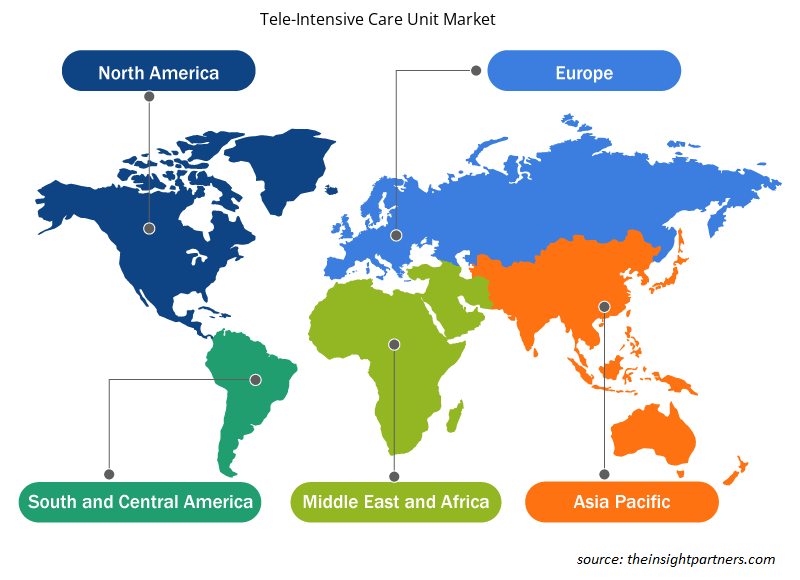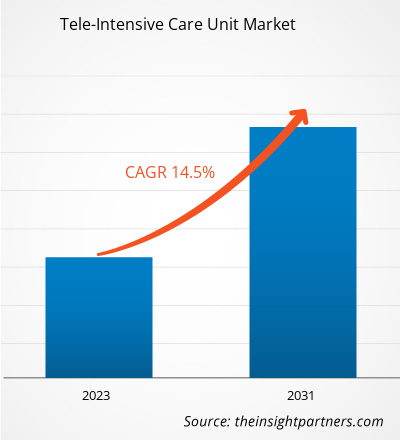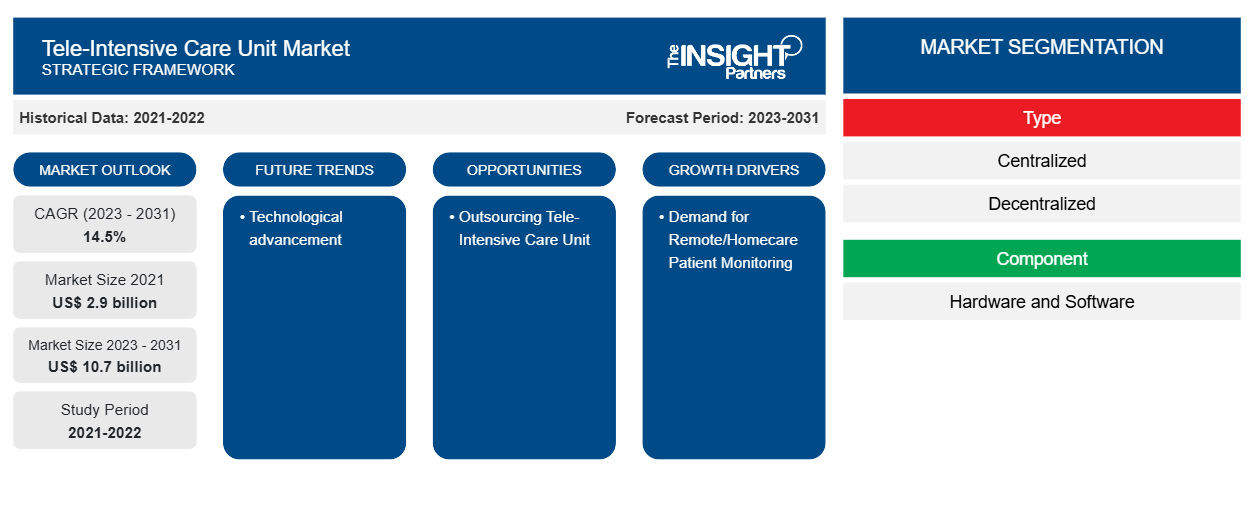遠隔集中治療室市場は2021年に29億米ドルと評価され、2031年までに107億米ドルに達すると予想されています。市場は2023年から2031年にかけて14.5%のCAGRを記録すると予想されています。
医療施設におけるテクノロジーとヘルスケアの統合の増加は、遠隔集中治療室市場の重要なトレンドであり続けると思われます。
遠隔集中治療室市場分析
遠隔/在宅患者モニタリングの需要
遠隔 ICU を導入すると、入院、再入院、遠隔治療の提供が少ない病院の全体的なキャパシティーとスループットが向上します。また、遠隔 ICU は在院日数 (LOS) を短縮できるため、病院は集中治療ベッド数と関連する ICU スタッフのコストを維持してより多くの患者を入院させ、キャパシティーとスループットを向上させることができます。医師と看護師の深刻な不足により、病院はより良い医療成果を達成するという大きなプレッシャーに直面しています。これに対処するために、さまざまな研究/調査により、遠隔 ICU は医療システムの運用改善に役立ち、より多くの患者を高コストでキャパシティーの高い三次病院/センターに転送するのではなく、キャパシティーの低い地域病院の ICU で治療できることが明らかになっています。たとえば、大規模な大学医療センター (AMC) と比較して占有率の低い地域病院に遠隔 ICU を設置すると、地域の ICU 施設に患者をより多く留め、収益サイクル管理 (RCM) を向上させ、医療提供の持続可能性を高めるという利点があります。前述の要因が遠隔集中治療室市場の成長に大きな影響を与えています。
遠隔集中治療室市場の概要
テクノロジー、イノベーション、スマートなテクノロジーソリューションは、遠隔集中治療室に大きな影響を与え続けています。遠隔集中治療室による遠隔/在宅患者モニタリングと効率的な病院成果の需要は、遠隔集中治療室市場の成長に最も影響を与える要因です。技術の進歩は、遠隔集中治療室市場の成長の重要なトレンドです。遠隔集中治療室のアウトソーシングは、有利な市場機会を提供します。
要件に合わせてレポートをカスタマイズする
このレポートの一部、国レベルの分析、Excelデータパックなど、あらゆるレポートを無料でカスタマイズできます。また、スタートアップや大学向けのお得なオファーや割引もご利用いただけます。
-
このレポートの主要な市場動向を入手してください。この無料サンプルには、市場動向から見積もりや予測に至るまでのデータ分析が含まれます。
遠隔集中治療室市場の推進要因と機会
遠隔集中治療室による効率的な病院の成果が市場に有利に働く
Koninklijke Philips NV のレポートで発表された統計によると、病院で実施された 5 年間の調査では、56 の ICU、32 の病院、19 の縮小された医療システムにわたる 188,990 人の重症患者に対する遠隔 ICU の影響により、患者の死亡率と入院期間 (LOS) が減少したことが明らかになっています。さらに、Koninklijke Philips のレポートで発表された別の調査では、遠隔 ICU によって医療過誤の請求がほぼ 90% 減少することが明らかになっています。
したがって、医療過誤請求の削減、死亡率の低下、入院患者の迅速な退院といった点での効率的な病院の成果は、今後数年間で遠隔ICU市場に大きく貢献するでしょう。
遠隔集中治療室のアウトソーシング - チャンス
収容能力の低い医療ユニットや病院(ICU ベッド数が 50 床未満)の場合、社内設備で完全なエンタープライズ遠隔 ICU を実装することはできない可能性があります。したがって、小規模の医療ユニットや病院は、トップの遠隔 ICU サービス プロバイダーと連携できます。たとえば、エンタープライズ遠隔 ICU サービスに対する Philips のモジュール アプローチにより、収容能力の低い医療ユニットや病院は、効率的な実装計画を使用して、大規模な ICU ベッドを拡張/調達できます。たとえば、Philips の「eICU アウトリーチ プログラム」では、最小限の投資でパートナーシップを通じて、小規模から大規模の集中治療ユニットや病院まで、広範囲にアクセスできます。したがって、収容能力の低い集中治療ユニットや病院による遠隔 ICU サービスのアウトソーシングの採用は、今後数年間で遠隔集中治療ユニット市場のかなりの市場シェアを占める有利な市場機会を提供します。
遠隔集中治療室市場レポートのセグメンテーション分析
遠隔集中治療室市場分析の導出に貢献した主要なセグメントは、候補者とサービスです。
- タイプに基づいて、市場は集中型、分散型、その他に分かれています。集中型セグメントは、2023 年により大きな市場シェアを占める可能性があります。
- コンポーネント別に見ると、市場はハードウェアとソフトウェアに分かれています。ハードウェアセグメントは、2023 年に市場で最大のシェアを占める可能性があります。
遠隔集中治療室の地域別市場シェア分析
遠隔集中治療室市場レポートの地理的範囲は、主に北米、アジア太平洋、ヨーロッパ、中東およびアフリカ、南米/中南米の 5 つの地域に分かれています。
北米は遠隔集中治療室市場を支配してきました。北米では、米国が遠隔集中治療室でかなりのシェアを占めています。米国に存在するトップクラスの医療機器企業の存在、製品の革新、技術的に高度な製品が、市場の成長に最も影響を与える要因です。今後数年間、アジア太平洋地域は最高の CAGR で成長すると予想されています。
遠隔集中治療室市場の地域別洞察
予測期間を通じて遠隔集中治療室市場に影響を与える地域的な傾向と要因は、Insight Partners のアナリストによって徹底的に説明されています。このセクションでは、北米、ヨーロッパ、アジア太平洋、中東およびアフリカ、南米および中米にわたる遠隔集中治療室市場のセグメントと地理についても説明します。

- 遠隔集中治療室市場の地域別データを入手
遠隔集中治療室市場レポートの範囲
| レポート属性 | 詳細 |
|---|---|
| 2021年の市場規模 | 29億米ドル |
| 2031年までの市場規模 | 107億米ドル |
| 世界のCAGR(2023年~2031年) | 14.5% |
| 履歴データ | 2021-2022 |
| 予測期間 | 2023-2031 |
| 対象セグメント |
タイプ別
|
| 対象地域と国 |
北米
|
| 市場リーダーと主要企業プロフィール |
|
遠隔集中治療室市場のプレーヤー密度:ビジネスダイナミクスへの影響を理解する
遠隔集中治療室市場は、消費者の嗜好の変化、技術の進歩、製品の利点に対する認識の高まりなどの要因により、エンドユーザーの需要が高まり、急速に成長しています。需要が高まるにつれて、企業は提供を拡大し、消費者のニーズを満たすために革新し、新たなトレンドを活用し、市場の成長をさらに促進しています。
市場プレーヤー密度とは、特定の市場または業界内で活動している企業または会社の分布を指します。これは、特定の市場スペースに、その市場規模または総市場価値に対してどれだけの競合相手 (市場プレーヤー) が存在するかを示します。
遠隔集中治療室市場で事業を展開している主要企業は次のとおりです。
- インタッチテクノロジーズ株式会社
- 高度なICUケア
- フィリップスNV
- セイバテレICU
- バナーヘルス
- 遠隔ICUケア
免責事項:上記の企業は、特定の順序でランク付けされていません。

- 遠隔集中治療室市場のトップキープレーヤーの概要を入手
遠隔集中治療室市場のニュースと最近の動向
遠隔集中治療室市場は、主要な企業出版物、協会データ、データベースを含む一次調査および二次調査後の定性的および定量的データを収集することによって評価されます。以下は、遠隔集中治療室市場の動向と戦略のリストです。
- 2023年7月、メダンタ(病院グループ)はGEヘルスケアと共同で「メダンタe-ICUプロジェクト」としてインドでテレICUサービスを開始すると発表しました。eICUプラットフォームは、深夜などの時間帯でもほぼリアルタイムの患者モニタリングを提供し、早期の患者介入を可能にします。
遠隔集中治療室市場レポートの対象範囲と成果物
「遠隔集中治療室市場の規模と予測(2021〜2031年)」レポートでは、以下の分野をカバーする市場の詳細な分析を提供しています。
- 対象範囲に含まれるすべての主要市場セグメントの世界、地域、国レベルでの市場規模と予測
- 市場の動向(推進要因、制約、主要な機会など)
- 今後の主な動向
- 詳細なPEST/ポーターの5つの力とSWOT分析
- 主要な市場動向、主要プレーヤー、規制、最近の市場動向を網羅した世界および地域の市場分析
- 市場集中、ヒートマップ分析、主要プレーヤー、最近の動向を網羅した業界の状況と競争分析
- 詳細な企業プロフィール
- 過去2年間の分析、基準年、CAGRによる予測(7年間)
- PEST分析とSWOT分析
- 市場規模価値/数量 - 世界、地域、国
- 業界と競争環境
- Excel データセット
最新レポート
お客様の声
購入理由
- 情報に基づいた意思決定
- 市場動向の理解
- 競合分析
- 顧客インサイト
- 市場予測
- リスク軽減
- 戦略計画
- 投資の正当性
- 新興市場の特定
- マーケティング戦略の強化
- 業務効率の向上
- 規制動向への対応























 無料サンプルを入手 - 遠隔集中治療室市場
無料サンプルを入手 - 遠隔集中治療室市場